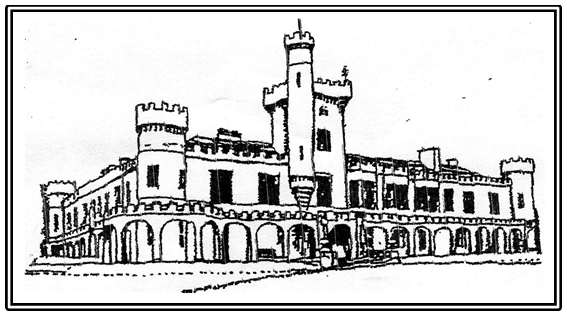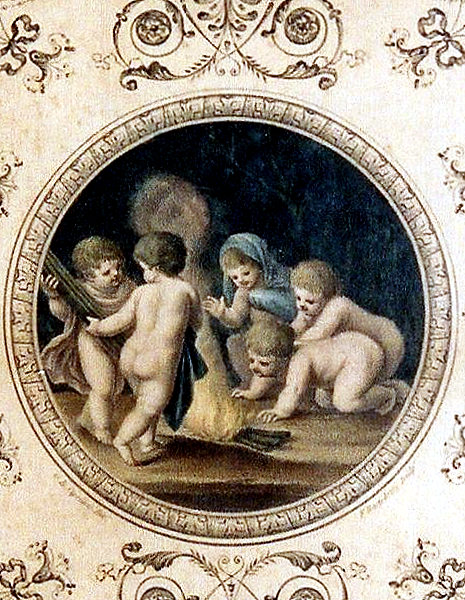Located in Kinloch Castle's Great Hall is this chronologically incorrect oil
painting of Mary Queen of Scots and her son,
part of the Sir George Bullough, Bt. Memorial, was accepted
as such by the Conservative Government of the day on behalf of the Nation.
The 26,400 acre island, with its fully furnished former late Victorian hunting lodge,
was entrusted by the government to Nature Conservancy,
to be used by as an outdoor laboratory for the
conservation and enhancement of Scotland’s natural heritage.
In 1992 management transferred to Scottish Natural
Heritage, (SNH), the Nature Conservancy successor agency totally funded from taxation and responsible
to the Scottish Parliament in Edinburgh, in 2019 / 2020 their budget was £46.5 million. (Over US$55,000,000. November 2022)
In November 2019 SNH changed its name to NatureScot, its budget for 2020 / 2021 was
£56.3 million almost US$65,000,000. (November 2022).
Headquartered at Great Glen House, Inverness,
this Scottish Government funded agency has 736 employees.
Regrettably in the intervening sixty-five years to today no
specific care body or funding
has ever been allocated or sought for the protection
and conservation of these magnificent
publicly owned treasures.
This work was
described by Phillips Art Auctioneers and Valuers, Edinburgh in 1978 as: “Bust
of Mary Queen of Scots in dark coat and coloured dress,
King James I as a boy at her side. 27½
x 35½ inches. Panel paint flaking.”
In 1992 and 1996 Phillips recorded:
"Follower of Marcus Gheerhardts. Portrait of Mary Queen of Scots with James I standing by her side and with child. Oil on panel. 71 x 91 cms."
In August 2007, Messrs. Bonhams, (founded in 1793, and one of the world’s oldest and largest auctioneers
of fine art and antiques), described the work as:
"Follower of Marcus Gheerhardts.
Portrait of a lady, said to be Mary Queen of Scots, with a child, said to be the future
King James I, another at her side (unlikely as Mary only had one child.)
Oil on panel. 71 x 91 cms."
*
The portrait was one of a "Survey of the Condition of 25 Easel Paintings at Kinloch Castle" examined in March 1996 by a professional art conservator.
The work, one of three of the twenty-five surveyed,
was described as being in
“extremely poor
condition, in need of urgent work.”
*
Description:
"Title: Mary Queen of Scots with James VI when a child."
"Artist: after Holbein. * Medium: oil. * Support: panel."
The Conservator's Report, now twenty-six years old, is comprehensive and highly critical: The work was examined framed.
"The structure as well as the
surface of the painting is fragile and, as the painting could be examined
easily from the back, it was not removed from the frame."
The painting was deemed "structurally
unstable throughout. Dramatic losses in the lower right area reveal the thinly
gessoed* wood beneath.
This problem has been continuing over many years and the
back of the panel bears witness to attempts to restrain its movement and arrest
the problem.
The three sturdy horizontal battens have
however created other problems."
* Gessoed: A white ground of plaster and size used to prepare panels or canvas for painting especially in the Middle Ages and Renaissance.
 |
In 1996 a professional art conservator was commissioned by Scottish Natural Heritage to survey twenty-five paintings in Kinloch Castle. Her Report on this painting included the comments:
“There is an
area, approx. 23 x 34 cms. actively flaking and delaminating in the lower right
corner, as well as plenty of evidence of earlier losses in the centre of the
right side ... Water staining was noted along the bottom of the frame.
... ... the
paintings present location was not considered practical.”
*
“In the long-term there may well be no satisfactory
solution to the stabilisation of the painting other than maintaining it in a
stable environment and minimising the fluctuations of temperature and relative
humidity; at Kinloch Castle this is not practicable.”
*
Many recommendations were made, most required treatment off-site in a dedicated studio. Immediate action: "stabilisation and application of f acing tissue and adhesive across the surface of the painting to avoid any further loss of paint and ground layers."
*
The 1996 Report concluded none of the treatment
options could be “guaranteed to arrest the continuing problems displayed
by the
present surface condition of the painting.”
|
 |
"Structurally unstable, the painted panel is constructed of three sections of
timber which appear to have caused problems over a long period of time.
There has been movement along both vertical joints."
* |
Mary was
reputedly a red-head, but she often wore a wig in life and in portraits.
Portraits depict
her with “a small, well-shaped head, a long graceful neck,
bright auburn hair, hazel brown
eyes, under heavy lowered eyelids and finely arched brows, smooth luscious
skin, a high forehead, and regular, firm features.”
 |
| King James VI of Scotland and I of England and Ireland was born on 19 July 1566. |

Mary Queen of
Scots was born on 8 December 1542 at Linlithgow Castle, west of Edinburgh, the only surviving
legitimate daughter of King James V of Scotland and his wife Mary of Guise. Only six days
old when her father died, Mary was crowned on
9 September 1543 aged nine months
of age. Her reign lasted until 24 July 1567.
On 24 April
1558, eight months short of her sixteenth birthday,
Mary married fourteen year
old Francis II of France. A sickly child,
Francis died on 5 December 1560,
aged sixteen.
On 9 July 1565,
Mary married her first cousin, twenty year old Henry Stuart,
Lord Darnley,
their union produced a son, the future King James VI of Scotland
and King
James I of England and Ireland, born 19 July 1566 at Edinburgh Castle,
and
possibly the child in this portrait.
 Mary's marriage
to Darnley was not a happy one. On 10 February 1567, while
recuperating from a bout of smallpox, there was a huge explosion at the
Edinburgh house in which the couple were staying and Darnley was discovered dead
in the orchard, apparently
strangled, possibly smothered.
Mary's marriage
to Darnley was not a happy one. On 10 February 1567, while
recuperating from a bout of smallpox, there was a huge explosion at the
Edinburgh house in which the couple were staying and Darnley was discovered dead
in the orchard, apparently
strangled, possibly smothered.
(Modern science
suggests he died from internal injuries while fleeing the blast which would show no outward
damage leading to the conclusion at the time.)
Theories
abounded as to the perpetrators, thirty-three year old James Hepburn 4th Earl
of
Bothwell being
the leading contender having supplied the gunpowder for the explosion.
He was later
acquitted in a mock trial before parliament on
12 April 1567.
Thirty-three
days later, on 15 May 1567, at Holyroodhouse, Edinburgh,
Mary married Bothwell who had divorced
his first wife, Jean Gordon, twelve days previously.
A month later
the Scottish nobility turned against Mary and Bothwell and Mary was imprisoned
in Loch Leven Castle on an island in Loch Leven on 17 June 1767. Here she
became very ill and shortly after Mary miscarried twins she had
conceived with Bothwell.
On 24 July Queen Mary was forced to abdicate the Scottish throne in favour of her
one year old son, James; the future King James VI of Scotland
and King James I of England.
Mary, Queen of
Scots, was executed at Fotheringhay Castle on 8 February 1587,
she was
forty-four years old, her son James was twenty.
*
The following labels
and inscriptions are on the back of the frame:
The next label --
plus the stenciled 45 4 CD are to be found on another painting -
“Portrait of Charles II in a Yellow Coat” --
in the Kinloch Castle collection, indicate the pictures
were sold by Christies on the instructions of the Trustees of Sir Thomas Charles Callis Western, Baronet,
Felix Hall, Essex.
“Christie’s sale of .. the pictures .. which
hung at Felix Hall
were sold .. in June 1913.”
Sir Thomas
Western 3rd Baronet (1850 – 1917) is reputed to have squandered his
inheritance.
The first crash came in 1893, when, By Order of the High Sheriff of
Essex,
an auction of some of his property took place on 4 July at the Angel
Inn, Kelvedon.
*
In October 2011
opinion was sought from the Curator of 16th and 17th Century portraiture at the National Portrait Gallery, London, after being sent a photograph of the painting.
The replied stated::
“The
pregnant woman with child is not of Mary, Queen of Scots. She left James I
before he was one year old and didn’t have any more children and in any case
was dead by the time this picture was painted. Follower of Gheerhardts seems
fine as an attribution.”
This seems a
somewhat dismissive response, lacking any justification for being
so certain “The pregnant woman with child is not of Mary, Queen of
Scots.”
It
is an acknowledged fact Mary never saw her son again after her visit
to
him
in Sterling Castle in July 1657. Equally it is known Mary was pregnant with
twins
by
Bothwell, but miscarried after her imprisonment in June 1567.
Clearly the work is chronologically incorrect, but it could still, however imperfectly
be a representation of Mary, Queen of Scots, who was pregnant with twins,
even though at the time her only child James was less than one year old,
yet portrayed as a boy some years older.
As to the
artist, Marcus Gheerhardts the Elder (1520 - 1590) could well be a contender.
As a painter
associated with the Court in the mid-16th Century,
he would have
been aged forty-seven in 1567 the year Mary miscarried.
Equally, of course, the work could be by one
of his followers.
Then there is
the suggestion of an unknown artist after an original by Hans Holbein.
Were Christie's, the world's leading art business founded in 1766,
mistaken in describing the work as “Mary, Queen of
Scots and James I after Holbein ?”
*
So does the Kinloch Castle portrait depict Mary, Queen of Scots and her son, James ?
And who is the artist ?
It deserves a more careful and preferably first-hand look by more than one expert.
*
The painting is chronologically incorrect, an anachronism,
deliberately designed to help a contemporary audience engage more readily with a period in history.

Portraits depict Mary, Queen of Scots
with “a small, well-shaped head, a long graceful neck, bright auburn hair,
hazel brown eyes, under heavy lowered eyelids and finely arched brows,
smooth luscious skin, a high forehead, and regular, firm features.”
|
*
Don’t let Britain’s heritage be lost through indifference -
Express your concern by contacting:
The Scottish Parliament
St. Andrew’s House,
Regent Street,
Edinburgh, EH1 3DG, Scotland.
Telephone: 0141 424 1174
POSTED BY GEORGE W. RANDALL
TO RAISE PUBLIC AWARENESS TO THE NEGLECT AND POSSIBLE LOSS
OF ALL PUBLICLY OWNED ARTIFACTS IN KINLOCH CASTLE.
UPDATED 29 OCTOBER 2023


 Mary's marriage
to Darnley was not a happy one. On 10 February 1567, while
recuperating from a bout of smallpox, there was a huge explosion at the
Edinburgh house in which the couple were staying and Darnley was discovered dead
in the orchard, apparently
strangled, possibly smothered.
Mary's marriage
to Darnley was not a happy one. On 10 February 1567, while
recuperating from a bout of smallpox, there was a huge explosion at the
Edinburgh house in which the couple were staying and Darnley was discovered dead
in the orchard, apparently
strangled, possibly smothered.

































